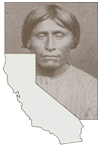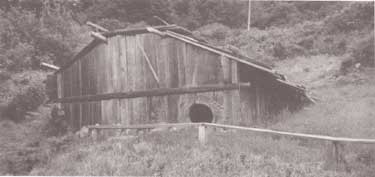![]()

Five Views: An Ethnic Historic Site Survey for California
MENU
Introduction
pre-1769
1769-1848
1849-1879
1880-1904
1905-1933
1934-1964
1965-1980
Historic Sites
Selected References

A History of American Indians in California:
HISTORIC SITES
Re-Kwoi (Requa)
Del Norte County
Re-kwoi was once a thriving Yurok Indian village of approximately 25 houses and 14 sweathouses. Covering an area of about 100 square meters, it was one of the most important Yurok sites on the northwest coast of California. (Waterman, 1920:Map 8) A single reconstructed redwood plank house now represents old Re-kwoi. The house is 150 years old, has a single pitched roof, and a round entry way that faces west. The site of Re-kwoi, located on a gravel road about one and one-half miles off Highway 101, is at the mouth of the Klamath River. Several distinguishing landmarks found near the site are a radar station to the north and three large rocks, White Rock, False Klamath Rock, and Wilson Rock to the south and east. Re-kwoi lies at the juncture of the coast and river divisions of the Yurok people. Situated on a moderate slope, it allowed easy access to the river and commanded a good view upstream and of the beach on the south side of the river mouth. An island, traditionally called "Oregos," to the west of the site, served as a field for playing the Indian Stick Game. There is a dense cover of alder, hazel, nettle, cow parsnip, thimbleberry, Scotch broom, and equisetum around the site. The only cleared areas are where modern structures are located, including the reconstructed dwelling, a shed, and a cemetery above the house site.
Re-kwoi means "creek mouth" in the Yurok language. It derives its meaning from the name of the village and clan on the north side of the mouth of the Klamath River. Prior to contact, each Yurok village had a chief, and the clans and villages carried the same name. Both sides of the Klamath River supported dense populations of Yurok Indians. In 1881, A. J. Bledsoe put the number of Indians in Klamath County at 3,000 to 5,000 individuals, most of them on the Klamath River and its tributaries.
The Yuroks of Re-kwoi were hunters, fishermen, and gatherers. Important food resources included salmon, seals, sea lions, marine fish, mollusks, shore birds, migratory waterfowl, bear, elk, deer, and rabbits. By 1829, they had established fur trade relationships with representatives from the Hudson Bay Company. In 1848, the first miners under Pierson B. Reading entered the area of the Trinity River. No one exploited the Re-kwoi region extensively until 1850, but by 1851, Yuroks were working as miners and furriers. An 1852 census taken by a fur trader indicated that Re-kwoi had 22 houses and 116 people.
Tension increased as more outsiders entered Yurok territory, and the inevitable outcome was conflict and killing between Yuroks and Whites. The Red Cap War which began in 1855 led to the removal of the Yuroks and seven other tribes to the Hoopa Valley Indian Reservation. The eight tribes were to share the reservation land equally, and retain the right to joint control forever. (Baker, 1967:8) In 1891, the U.S. Government enlarged the reservation to encompass a mile-wide strip down each side of the Klamath River for a distance of 40 miles to the Pacific Ocean; because this was part of the Yuroks' traditional land, they began to use it.
The Yurok fished on the extension along the Klamath River until 1964, when the Department of Fish and Game began arresting them and confiscating their nets. The region was part of the reservation, and was protected under U.S. law from outside interference. The Yuroks took the fishing issue to the Humboldt County Superior Court. They won, and when the case was appealed to the District Court of Appeals in San Francisco, the Humboldt decision was upheld. The final decision from San Francisco ruled that the Department of Fish and Game had seized fishing nets illegally, and that the State was preempted from jurisdiction in the case because reservation land was in question.
Today, the site of Re-kwoi and the areas adjacent to it continue to be part of a complex religious and social organization where the Jump Dance, Brush Dance, White Deerskin Dance, and Ghost Dance, which are part of the World Renewal System of the Yurok, take place. These dances have been held from time immemorial. The Jump Dance held at Re-kwoi was different in details from the "jumping dances held at nearby villages of Weitspus and Pekwan. The observances during the final two and one-half days were held under some trees on the flat at we'klwa. . . . In connection with this dance there was a 'sacred' house, opyu' weg (where they dance)." (Waterman 1920:231) Re-kwoi serves as a part of the past and present complex social structure of the Yurok Indians.

Re-Kwoi
NEXT> Roberts House
Last Modified: Wed, Nov 17 2004 10:00:00 pm PDT
http://www.cr.nps.gov/history/online_books/5views/5views1h70.htm
![]()
 Top
Top